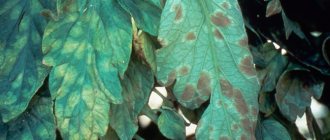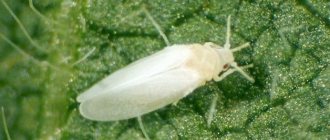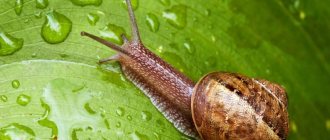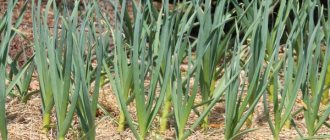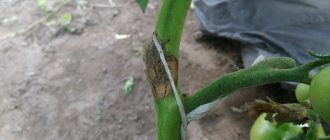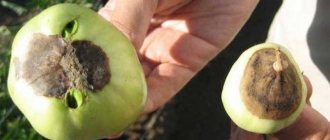Vegetable growing » Pepper
0
2995
Article rating
Kira Stoletova
When holes appear on almost ripened fruits or only veins remain from the leaves, a caterpillar has appeared in the pepper in the garden bed or in the greenhouse. You need to get rid of it as soon as possible before the plants receive severe damage.
Caterpillars eat peppers
Why do I get rid of caterpillars in the greenhouse?
I always try to prevent pests from appearing in my area. If uninvited guests show up, without wasting time, I begin processing the plants. Being late threatens the destruction of plantings and serious damage to the harvest.
Caterpillars, one of the most voracious pests, are especially dangerous here. If measures are not taken in time, they will deprive the harvest. Such pests can be found not only in open garden beds, but also in greenhouses. In the comfortable conditions of a greenhouse, they are active and voracious. They practically do not have to fear natural enemies - birds, predatory insects.
Having discovered caterpillars in the greenhouse, I turn to proven folk methods. If the method is not effective, turn to specialized chemicals. And I don’t forget about preventing the appearance of these gluttonous enemies.
Wireworm
The larvae of the click beetle, known as wireworms, love to eat the roots of sweet peppers. Caterpillars with a hard brown-orange body reach 1-4 mm at different periods of life. The larval stage lasts up to 4 years, during which time the pest parasitizes garden plants, damaging root systems and underground parts of stems.
The wireworm causes the most serious damage to potato beds, but other representatives of the nightshade family - tomatoes, bell peppers - suffer more than that. The fight against wireworms is lengthy, especially if a large number of the pest has accumulated on the site.
- manual autumn digging of soil with sampling of wheatgrass roots;
- sowing mustard near the beds, the smell of which wireworms cannot stand;
- treating the soil against diseases and pests before planting with a saturated solution of potassium permanganate;
- adding ash and lime to the soil.
Judging by the reviews of gardeners, many got rid of click beetle larvae using the drugs Prestige, Bazudin, Provotox. But when using chemicals, do not forget to follow the instructions.
What caterpillars appear in the greenhouse and what do they eat?
Gardeners need to be wary of two types of caterpillars: whiteflies and armyworms. I’ll tell you how to recognize them and how exactly these uninvited guests harm you.
Cutworm caterpillars
Adult representatives are inconspicuous butterflies that resemble moths. Quite small - 3-4 cm. Their body is gray-brown, and on the wings there is a pattern of strokes and stripes.
scoop butterfly
Cutworms are very prolific - an adult leaves up to 500 eggs over the summer. The masonry is made on the leaves and flowers of greenhouse plants. Armyworm eggs are convex on top and flat on the bottom. In warm conditions they ripen in 2-5 days, in cool conditions - in 4-10.
The caterpillar itself takes longer to develop – up to 20 days. Its body is naked, grayish, yellow-green, brownish dim in color. The pests are large and long – up to 2 cm. It is quite difficult to detect them – both caterpillars and cutworm butterflies are active at night. At the end of the development stage, the caterpillars move into the soil, where they pupate and survive the winter. Adult cutworms live 20-40 days.
The caterpillars do the greatest harm to greenhouse tomatoes - they start their “lunch” with tops and buds, and then move on to tomatoes. They gnaw holes in the fruits, where they live and feed, “without leaving the cash register.” Tomatoes affected by caterpillars are not suitable for consumption. In addition to tomatoes, pests are not averse to eating eggplants, cabbage, and peppers.
Whiteflies
Adult whiteflies are very small (2-3 mm) butterflies that can easily be confused with midges. I recognize them by their white, yellowish body, wings with white “powder”. I detect whiteflies by moving and shaking the seedling - the butterflies immediately take off in a friendly swarm.
Both caterpillars and adults live on the lower part of the leaves, sucking cell juices from them. The larvae themselves are practically invisible to the human eye - small, translucent. In the first days of life they are mobile. Then they attach to the feeding site and practically do not move.
Warm and humid greenhouse climates are the most favorable for whiteflies. When the temperature drops to 10 C they die. But the eggs laid by whiteflies calmly survive the winter cold in the upper layers of the soil.
whitefly on vegetables
The danger of whitefly caterpillars is not only in drawing out cell sap. These pests are carriers of infections. Plants are inhibited in growth, do not form new ovaries, and produce deformed fruits unsuitable for nutrition. Whitefly affects most greenhouse crops - tomatoes, peppers, eggplants.
Holes appeared on pepper leaves
If the bell pepper leaves are all full of holes, who will eat them? Perforated leaves and fruits are evidence that the vegetable crop has been attacked by pests. If caterpillars and signs of plant damage are detected, immediate action should be taken. In advanced cases, it will be difficult to deal with the problem.
Knowing the main signs inherent in individual types of pests will help you find out who eats bell peppers in your garden beds.
Slugs
The enemy of sweet pepper plantings is the slug. This is a land mollusk that visually resembles a snail without a shell. The pest's mouth contains many teeth (chitin), which it uses to grind food.
A plant damaged by a land mollusk is identified by the presence of even round holes on the leaves and a corroded edge. Slugs also tend to damage fruits: characteristic marks will be visible on them. Another sign of slug damage is white tracks on the leaves of pepper. They are formed by dried mucus left by the mollusk when moving.
Slugs prefer a nocturnal lifestyle. During the day they hide, burrowing 3 cm into the ground. They lay eggs there.
Aphid
A common pest that affects bell peppers in garden beds is aphids. Plantings in open and closed ground suffer from it.
Peppers are susceptible to black and green aphids. The pest settles on the inside of the leaf. He eats fruits, leaves, and stems of the plant.
A number of signs indicate the presence of aphids:
- deformed and withered leaf blades;
- dry, round areas and the presence of holes on leaves and fruits;
- sticky sweetish coating on the leaf blade;
- black grains are sooty fungus.
Aphids attack bell peppers due to improperly prepared soil in the fall or spring. The eggs of the pest overwinter under a layer of fallen leaves, and with the onset of spring warmth, females emerge from them en masse and lay eggs on plants. The peak of aphid attacks on sweet pepper plantings occurs in the first month of summer.
Colorado beetles
Among the enemies of bell peppers are the larvae of the Colorado potato beetle. A large number of orange eggs appear on the leaves on both sides, which are laid by adult individuals.
If holes appear in the central part of the leaf blade, it means that the larvae are eating the pepper. Then the edges of the sheets become eaten. If no action is taken, the pest will leave bare petioles.
Cutworm caterpillars
More than a hundred varieties of cutworms can damage sweet pepper plantings. The enemy enters the garden in the form of an inconspicuous brownish or gray butterfly, on the wings of which there are kidney-shaped orange spots.
The cutworm caterpillar is green in color with a light green stripe on the side and transverse lines on the back. It appears on the surface only at night.
The armyworm eats vegetables in a similar way to other types of caterpillars. It eats away at the edges of the leaf plate and can damage the fruit. The pest is most active in the summer months.
Signs of caterpillars appearing in a greenhouse
I recognize its appearance by characteristic signs:
- Small and adult pests appear on the lower part of the leaves.
- The upper part of the leaf is covered with white “powder” and then turns black.
- Tops affected by caterpillars dry out and curl.
- Affected tomatoes have inedible, whitish pulp.
- The tops have characteristic features: “bite” marks, uneven edges, empty spots.
- There are gnawed passages on the tomatoes, and the pests themselves are in the pulp.
Cutworm caterpillars are clearly visible to the naked eye. Adult whiteflies can be easily detected by shaking the plants - the butterflies will swirl in the air.
Classification of larvae
The digestive tract of these creatures is concentrated at the back and front of the body. This helps you digest food calmly even while moving. Their digestive tract secretes enzymes that help them process food easily. Scientists classify the larvae depending on what the caterpillar eats.
Polyphages - eat plants
These insects are polyphagous, as they consume any plant for food, indiscriminately. These include moths (moth, wine hawk moth, peacock eye). The advantage of polyphages is that they exist with an unstable food supply. Weakness: poor digestion of food.
Oligophagous - eat plants of a certain type
They prefer to eat one type of plant, one family or type, and do not allow mixing. These include the polyxena species, which feeds only on some of the genus Kirkazon, and the Mahayana larvae only on celery. Or the codling moth, which eats apples and plums.
Monophagous - eat a strictly specific type of plant
These are the most selective individuals who prefer to eat one type of plant. An example is the silkworm larva, which eats only mulberries.
Xylophages - eat wood
Wood is the only thing the caterpillar of this species feeds on. Xylophages make up a minority, compared to other species, their number is insignificant. They gnaw tunnels in tree trunks and branches. The roots of herbaceous plants can act as food due to their woody composition.
Why do caterpillars appear in a greenhouse?
Caterpillars enter the greenhouse in two main ways:
- An adult flew into a greenhouse and laid eggs. Caterpillars have already developed from them.
- The soil in the greenhouse is contaminated - pupae and larvae remain from last season. With the onset of warmth, they become active, quickly develop and reproduce.
Cutworms and whiteflies are attracted by the comfortable greenhouse microclimate - warmth, humidity. Therefore, I do not forget to ventilate the greenhouse to get rid of condensation and ensure normal air circulation.
Pests also love overly thickened plantings - they lay eggs there. Therefore, timely weeding, thinning, and formation of cultivated plants are so important. Do not forget to cut off stepsons, old lower branches, and unnecessary side shoots.
Thrips
Representatives of fringed winged insects quickly fly (almost jump over) over pepper bushes, laying colonies of eggs.
Insects are small in size (up to 1-1.5 cm), a pair of wings, and small antennae. The larvae and adults suck the juice from the leaf blades, causing the plants to dry out and die. In addition, thrips often carry infections that are dangerous for peppers, aggravating the situation.
- spray the plantings with infusion of marigolds (tagetes): per liter of water - 300 grams of flowers, infuse for two days;
- installation of traps with sticky surfaces in greenhouses;
- To protect against pests, peppers are treated with infusion of garlic or onions.
The chemicals used to exterminate thrips are Confidor, Actellik, Karbofos, and Vertimek.
Methods for getting rid of caterpillars in a greenhouse
I will present to you effective ways to resist caterpillars, which I have already tried from my own experience.
Chemicals
The most effective counteraction to caterpillars is the use of pesticides. But I will warn you that these products are also dangerous for people: pesticides are completely removed from the plantings and their fruits in at least 20-30 days. Therefore, I always calculate the expected harvest time before processing. If this period is short, I still prefer to use other drugs.
Treating greenhouse plants with insecticides is a last resort. Toxic substances enter the greenhouse substrate, accumulate there, and are absorbed by more than one generation of plantings. The drugs of the 4th hazard class are the fastest to be removed from plants - “Aktofit”, “Lepidotsid”, “Fitoverm”, “Agravertin”.
I always carry out processing in closed conditions with all precautions - I cannot do without a respirator, protective clothing, thick gloves and goggles. I open the windows and doors and try to spray the plants as quickly as possible.
For treatment, I choose universal preparations that destroy both caterpillars and adult whiteflies, cutworms:
- "Intavir". The active ingredients affect caterpillars at all stages of development and repel adult butterflies. I use the drug only for treating plants - as a preventive measure it is too strong a remedy.
- "Avant." Impact on both caterpillars and laid eggs. The product is very toxic - I don’t use it more than 2 times a summer. "Decis". A potent drug that protects against pests for 10-15 days.
To protect seedlings from caterpillars, buy the drug “Prestige”. Dilute the solution according to the instructions, place the seedlings in it before moving for 30 minutes. One treatment is enough to keep pests away from the plant all season.
Specifically for greenhouse tomatoes, I also recommend Admiral, Iskra, Aktaru, and Mospilan. The listed funds have one drawback in common - they can only be used once. Pests become immune to such insecticides.
Traditional methods
If you want to limit yourself to folk remedies only, start processing as soon as possible. Such methods are effective only at the initial stages of the spread of the pest.
The first thing I do is prepare one of these concentrates:
- Garlic. I collect a bunch of arrows (replaced with one head of garlic), finely chop them, pour them into a 1-liter container. I pour boiling water over it and let it sit for 3 days. For the solution you need ½ cup of infusion per bucket of water.
- Polynova. I fill the bucket 1/3 full with freshly cut wormwood and fill the green mass with water. I put it on low heat and boil for 30 minutes. Then I let the mixture sit for 2 days, filter it, and dilute the concentrate with water 1:10.
- Tobacco. I heat a bucket of water, pour 300 g of shag into it. Then I insist for a day.
I always add laundry soap to all prepared formulations. It makes the solution more sticky - the liquid stays on the greens longer and acts longer against pests. It is enough to grate 1/3 of the bar. Stir the shavings until completely dissolved, pour the liquid into the sprayer tank, and treat the plants from bottom to top. Pay attention to the lower parts of the leaves - this is where pests most often hide.
Specifically, I fight whiteflies with the following proven methods:
- Processing under pressure with cold water. I carefully lift the leaves to wash away the pest from both the outside and the inside. In order for the plants to survive the procedure less painfully, I carry out the procedure early in the morning, before they warm up under the sun.
- Soap foam treatment. I dissolve shavings of laundry or green soap in water. I beat the mixture until a thick foam forms. I collect bubbles with a sponge and lubricate the foliage on both sides.
I’ll tell you about other popular ways to combat greenhouse caterpillars:
- Fumigators. As practice shows, the devices effectively resist butterflies and their caterpillars. Do not forget to tightly close doors and windows before processing.
- Yellow traps. For whiteflies, the most attractive color is rich yellow. Gardeners find cardboard, paper of the desired shade (or paint it themselves), and cover the material with any sticky substance - honey, thick oil, Vaseline, garden glue. Caterpillars, of course, do not fall for the trap, but it is very effective against flying individuals.
- Traps made from compote, kvass. Containers with drinks are dug into the soil at ground level. Striving for a scent that is appetizing to her, she drowns in the bait.
- Burdock infusion. The green part of the plant is finely chopped and filled with water. The composition is infused for 3-4 days. Strain, combine with soap shavings, and spray the plantings.
- Saline solution. Dilute the salt in heated water and spray the affected plantings with the mixture. Salt corrodes the bodies of caterpillars - they die.
- Infusion of potato tops. The green mass is filled with water 1:10. The mixture is infused and strained. Add a little shavings of laundry soap and stir until completely dissolved. If a little product remains after spraying, it can be used to treat currants and roses.
- Complex green solution. Chop 500 g of wormwood, celandine, 250 g of garlic cloves, add tobacco. Pour 10 liters of water, stir. Leave for a day, strain, add shavings of ½ piece of laundry soap.
Traditional methods are the safest and most environmentally friendly. They definitely do not harm the plant and will not poison the harvest.
Folk remedies
First you need to try to get rid of pests on pepper using folk remedies. Gardeners recommend sprinkling the bushes with dry wood ash, and also spraying them with a solution based on:
- salt – 1 kg per 10 l;
- mustard – 10 g per 10 l;
- red hot pepper – boil 100 g in 1 liter for 2 hours.
Bell peppers can be treated with an infusion of burdock leaves. An extract based on garlic or onion peels works well against pests. A solution of soda will help make slugs leave the bushes. To do this, you need to dilute 50 g of powder in 5 liters of water. Sprinkle the mixture over the peppers.
Attention!
After one application, pests may remain on the bushes. Gardeners advise repeating spraying 3-4 times with a break of a week or 10 days.
Prevention of caterpillars in the greenhouse
I try to prevent pests from living in the greenhouse - it’s much easier and safer than resisting them. I recommend simple preventive measures:
- At the end of the season, I clean up all the plant debris in the greenhouse - there may be pest eggs on them. I burn garbage in an iron bin.
- Every autumn I carry out a deep digging of the greenhouse soil - the larvae, cutworm pupae and whiteflies overwinter in the substrate. If caterpillars occupied the greenhouse last season, the top layer of soil (at least 15 cm) should be removed and replaced with fresh, uninfected soil.
- In the spring, I always disinfect the greenhouse soil - I water it with a saturated manganese solution or boiling water.
- I carry out weeding in a timely manner - caterpillars often settle on weeds, after which they crawl onto cultivated plants.
- I try to water the seedlings at the root. I carry out water procedures in the morning - the moisture has time to evaporate by the evening. This is necessary so as not to create warm, high humidity that is comfortable for the caterpillars.
- If there are self-pollinating plants in the greenhouse, I make barriers to the penetration of insects on the doors and windows - gauze, tulle curtains, mosquito nets.
- I carry out preventive treatments with Decis and Cytcor. I usually act in two stages - I plan to spray again after 1 week.
Caterpillars are small but very voracious pests. If you do not confront them in time, uninvited guests will destroy your greenhouse plantings and leave you without a harvest. Try to prevent caterpillars from appearing in the greenhouse - do not forget about simple but effective prevention.
